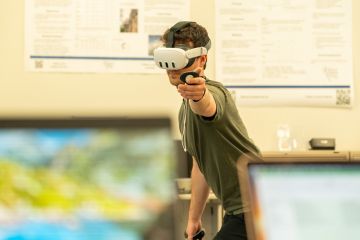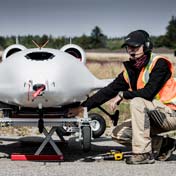New device allows everyone to rack 'em up
When the University of Victoria’s CanAssist team held its Christmas party in 2008, everyone had a great time shooting pool—everyone except Dan Spelt, a research assistant in CanAssist’s software lab who has cerebral palsy and is unable to hold a billiard cue. CanAssist develops and delivers innovative technologies and services to improve the quality of life for those with special needs. That night, Darcy Lane, CanAssist’s manager of hardware, said that someday the team would create a device that would enable Dan to play pool.
“I thought he meant it would be nice to do,” recalls Spelt. “I thought he was just making conversation.”
But the idea for an automated billiards device that could be used by people with disabilities began to take shape a year later when Lane provided it as a design option for a third-year engineering class. A team of five co-op students rose to the challenge and created a wooden structure with an ingenious design.
A few months later, their concept was taken to the next level by a group of four German exchange students, who replaced the wooden frame with one made of aluminum and added dozens of parts designed to make the device fully automated. In the end, most of CanAssist’s engineering team had a hand in the project, which was unveiled Dec. 23 in the billiards room at the University Club.
“We wanted to make a device that would allow Dan or anyone who can’t hold a billiard cue to play pool just by moving their head or using their facial muscles,” says Lane.
“As a prototype, it’s really amazing—especially considering the number of people involved, the degree of complexity of the project and the relatively short amount of time we had to work on it.”
The device is attached to a power chair and features a camera, a video monitor, pan-and-tilt control and a laser-guided cue. It allows users to play billiards by pressing one or two switches with their head, or by activating a switch that responds to the movement of the facial muscles—such as raising an eyebrow or tightening the jaw.
“To our knowledge, no one in the world has produced anything like this device,” says CanAssist Director Dr. Nigel Livingston. “It perfectly demonstrates the incredible ingenuity and passion within CanAssist that allows us to produce empowering technology.”
Lane says he hopes to get more UVic engineering students involved in fine-tuning the prototype in the months to come.
Meanwhile, Spelt now has the opportunity to participate in a game he thought he would always watch from the sidelines. He says using the device requires a lot of precision and provides a great physical and mental challenge.
“It’s a bit like playing a video game,” says Spelt. “It’s fun and it really makes me work.”
The billiards device is one of more than 150 unique technologies developed by CanAssist. The group has provided direct assistance to many hundreds of clients in the Victoria area, across Canada and internationally.
More information: www.canassist.ca
In this story
Keywords: technology, research, CanAssist
People: Dan Spelt




